Have you ever marveled at the beauty of a moon cactus, with its spherical form and mesmerizing patterns? If you’ve been captivated by this unique plant and wish to expand your collection, you’re in luck!
In this comprehensive guide, we’ll embark on a journey through moon cactus propagation. Whether you’re a seasoned or newbie gardener, grab your gardening tools, and let’s start propagating through moon cactus pups.
How to Remove a Moon Cactus Pup
1. Check for the fittest pup.
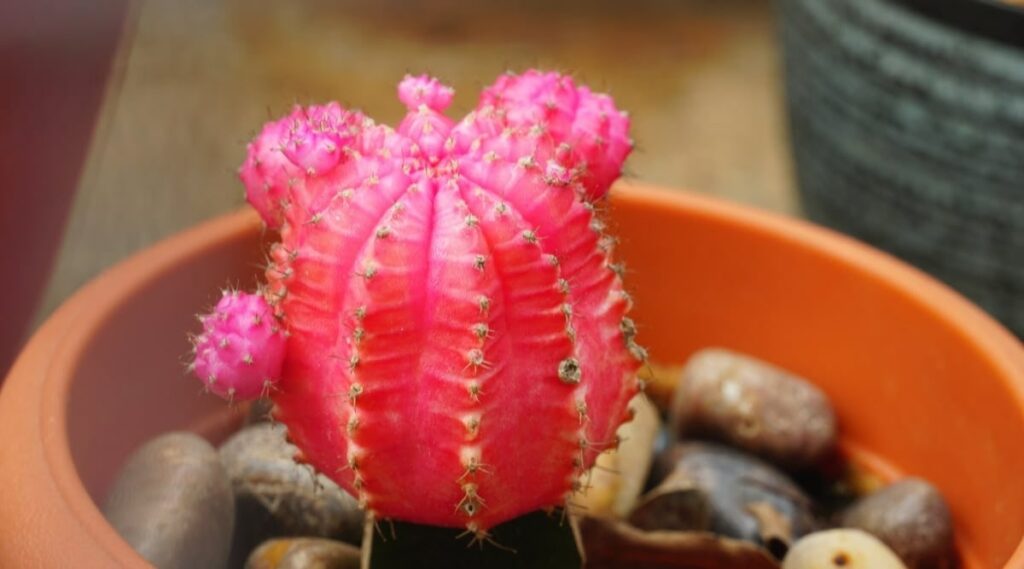
Check your cactus and pick the healthiest, good-sized offset. Healthy pups have bright colors, are free of pests and fungus, have no wounds, and are plump.
Too small and unhealthy offset has a slight chance of survival as they tend to dry up quickly. However, a healthy, decent-sized pup will most likely succeed when grafted.
Many cacti grow slowly, and grafting can be used to encourage growth. Following that, the growth rate is increased by 5 to 6 times.
2. Twist and turn.
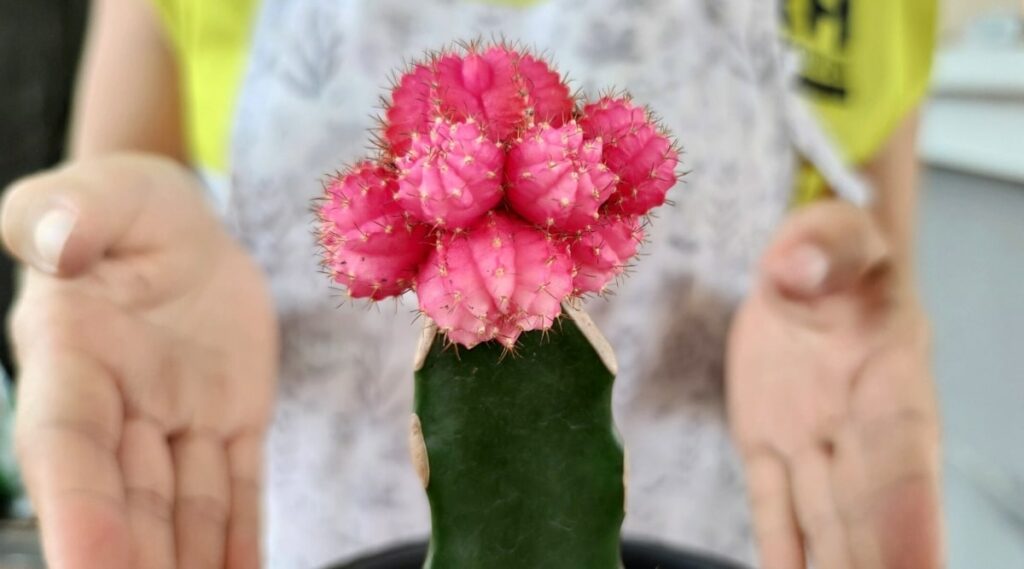
The pup of the moon cactus comes off easily with a twist and a turn. While holding the crown of your moon cactus, twist the offset gently using your fingers and turn it slightly until it breaks off.
You can use gloves or tweezers if you can’t withstand their not-so-sharp spines. But just be careful when using tweezers because you might poke your cactus and leave them wounded.
Also, avoid pulling off the pup harshly, as it might damage the mother plant’s tissues or the offset.
3. Propagate the pup.
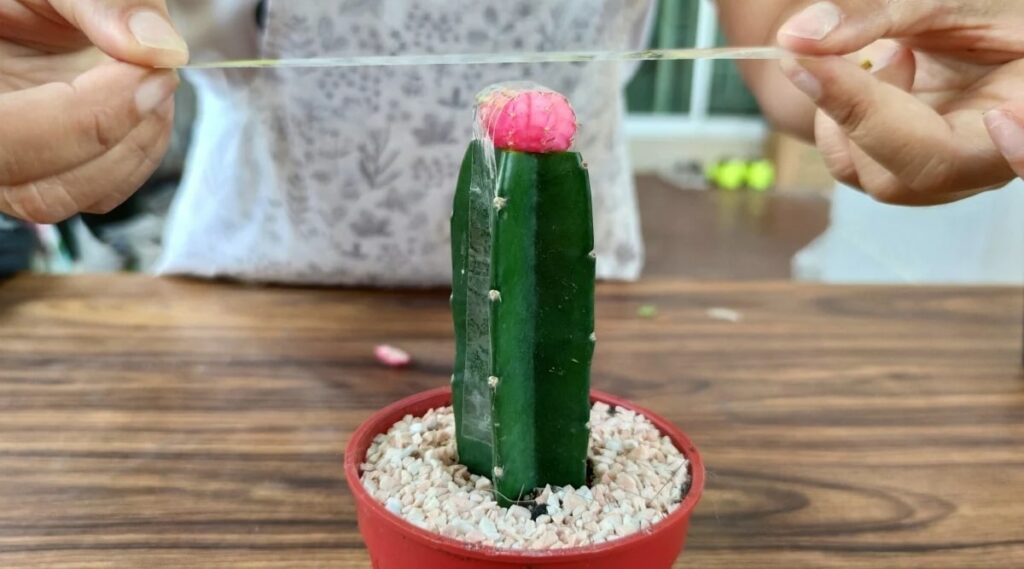
| Difficulty | Easy ●○○○○ |
| Duration | 15 to 30 minutes |
| Things You Need | Sharp knife or razor blade Rubbing alcohol Grafting stock (e.g., dragonfruit, Hylocereus) Scion (moon cactus pup) Rubber bands or masking tape Transparent plastic wrap Potting mix Watering can |
How To Do:
1. Prepare the grafting stock.
Cut a flat top on the grafting stock, approximately 2 to 3 inches in diameter. Keep the cut is clean and free of any debris.
2. Prepare the scion.
Cut the bottom of the moon cactus pup flat and make sure that it matches the size of the cut on the grafting stock.
3. Sterilize the surfaces.
Clean the cut surfaces of the grafting stock and scion with rubbing alcohol to prevent the spread of bacteria.
4. Position the scion.
Place the scion on top of the grafting stock. Align the cut surfaces as closely as possible.
5. Secure the graft.
Using rubber bands or masking tape, bind the scion tightly to the grafting stock to ensure the two surfaces remain in contact for proper healing.
6. Cover the graft.
Wrap the graft with transparent plastic wrap to maintain humidity and prevent the scion from drying out.
7. Place the grafted plant in a warm, bright location.
Keep the grafted plant in a warm, bright location but out of direct sunlight. Allow the soil to dry slightly between waterings.
8. Monitor the graft.
Check the graft regularly for signs of healing, such as the scion turning green and firmly attaching to the grafting stock. Once the graft has healed, remove the rubber bands or masking tape and plastic wrap.
9. Transition to regular care.
After the graft has healed, you can begin caring for the grafted plant like a normal moon cactus. Water it regularly and provide plenty of sunlight.
\Can moon cactus pups develop roots?
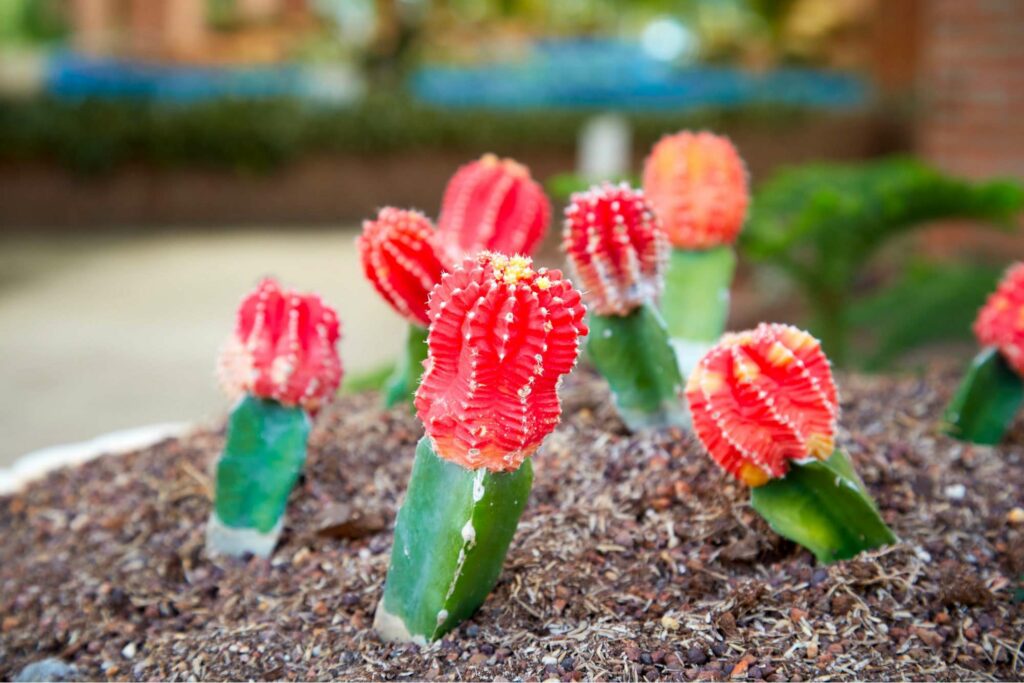
Moon cactus pups cannot develop roots on their own. Moon cacti are grafted onto another cactus, called a rootstock, which provides the moon cactus with the seeds it needs to survive.
Moon cacti are genetically engineered to be dependent on a rootstock for survival. The rootstock provides the moon cactus with the nutrients and water it needs to grow and thrive.
It’s also worth noting that cactus pups lack chlorophyll, the pigment that allows plants to photosynthesize and produce food. Without such pigment, moon cactus pups cannot generate the energy they need to grow roots.
Hence, the grafting process allows the moon cactus pup to access the rootstock’s vascular system, enabling it to receive nutrients and water from the rootstock.
What happens if the moon cactus pup is not removed?
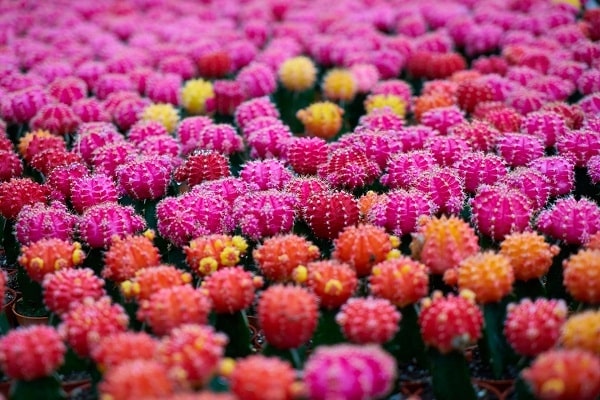
If the moon cactus pup is not removed, it will continue to grow and eventually crowd the parent plant. This can cause the parent plant to become stressed and may even lead to its death.
The parent plant may experience stunted growth due to competition for resources from the pups. The pups may overly consume essential nutrients and water the parent plant needs, leading to nutritional deficiencies.
Because of this, the parent plant may become stressed due to the crowding and competition from the pups. Negative impacts of stress affect a parent plant and make them more vulnerable to attacks from pests and diseases.
We recommend removing moon cactus pups when they reach a size of one-inch diameter regularly to maintain the health and vigor of the parent plant.




